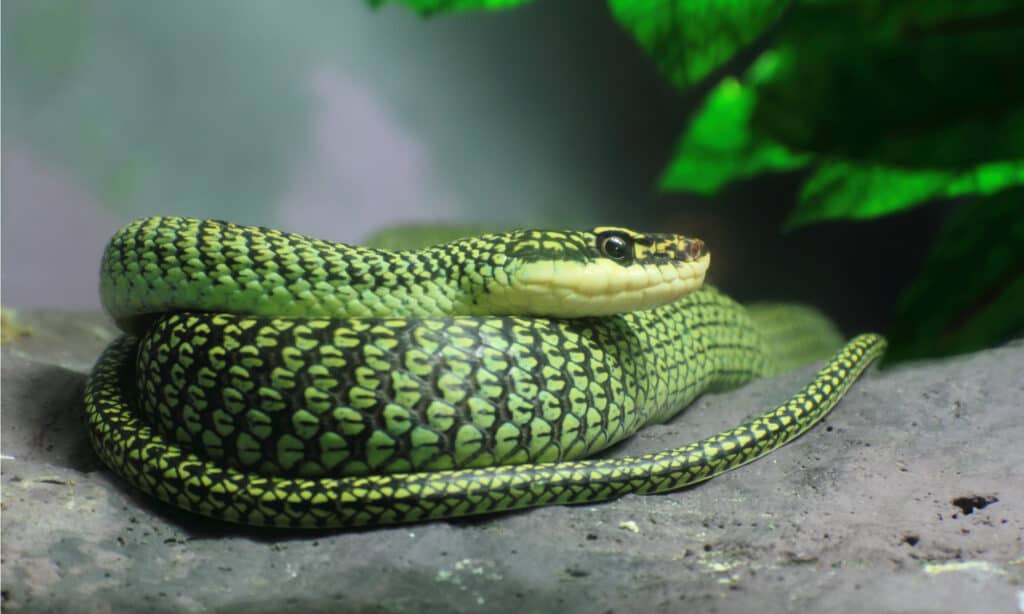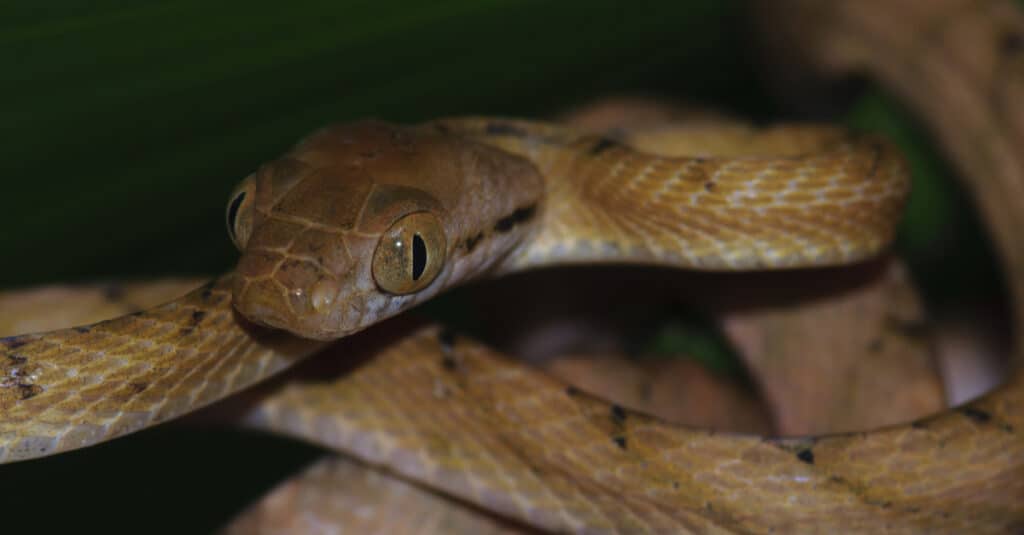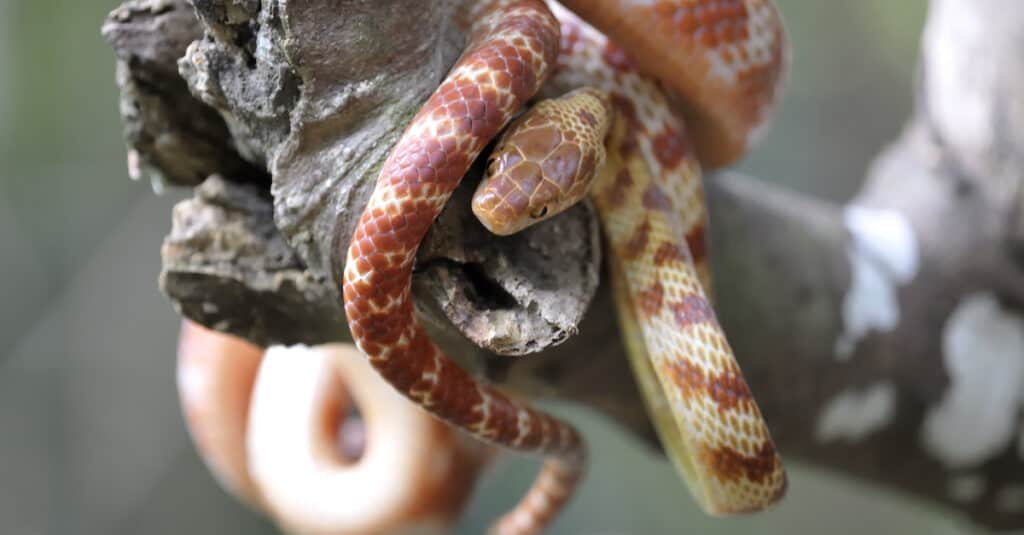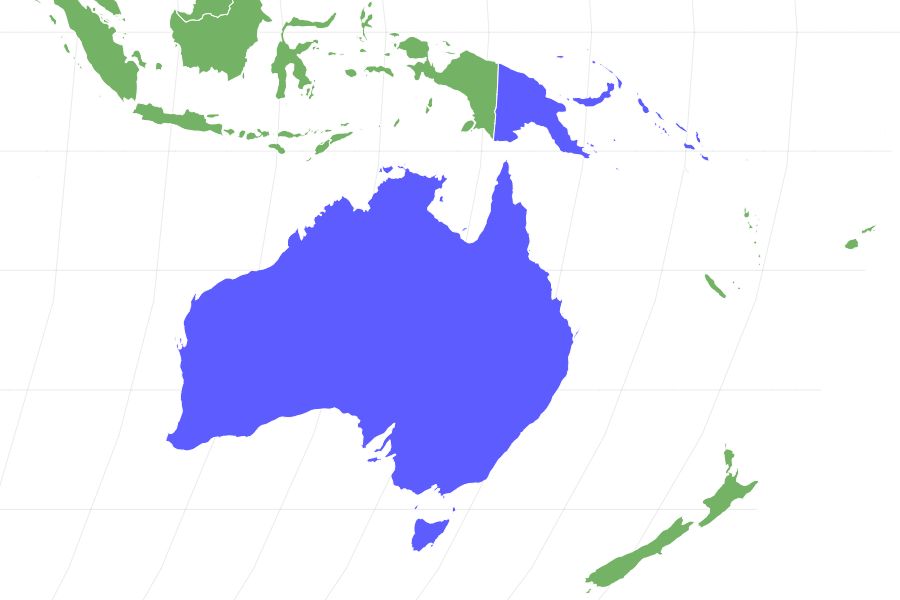Tree Snake
Boiga irregularis
Though this snake’s venomous bite isn’t harmful to adults, it can be dangerous to children
Advertisement
Tree Snake Scientific Classification
- Kingdom
- Animalia
- Phylum
- Chordata
- Class
- Reptilia
- Order
- Squamata
- Family
- Colubridae
- Genus
- Boiga
- Scientific Name
- Boiga irregularis
Read our Complete Guide to Classification of Animals.
Tree Snake Conservation Status
Tree Snake Facts
- Prey
- Frogs, birds, lizards
- Fun Fact
- Though this snake’s venomous bite isn’t harmful to adults, it can be dangerous to children
- Most Distinctive Feature
- Large eyes and vertical pupils
- Distinctive Feature
- A large head compared to its slender body
- Other Name(s)
- Cat snake
- Diet
- Omnivore
- Lifestyle
- Nocturnal
- Common Name
- Brown tree snake
- Origin
- Australia
- Nesting Location
- In a crevice or beneath a rock to keep them cool
Tree Snake Physical Characteristics
- Skin Type
- Scales
- Lifespan
- 10-15 years
- Age of Sexual Maturity
- 3-4 years
- Venomous
- Yes
- Aggression
- Medium
View all of the Tree Snake images!
It’s sometimes called a cat snake because of its large eyes and vertical pupils.
The brown tree snake lives in the northern and eastern parts of Australia, in Papua New Guinea, the Solomon Islands as well as on the island of Guam. This snake is large in size sometimes growing to a length of 6.6 feet. It is venomous with fangs located in the back of its mouth. It eats bats, birds, rats, and lizards. It’s considered an invasive species in Guam.

Four Amazing Facts
- The longest one on record is 9.8 feet
- It lays four to 12 eggs in a crevice or beneath a rock to keep them cool
- This snake breeds year-round
- Though this snake’s venomous bite isn’t harmful to adults, it can be dangerous to children
Where to Find a Tree Snake
These snakes live in Australia, Papa New Guinea, the Solomon Islands, and Guam. They live up to their name by spending a lot of time hunting in trees. They also hunt for prey on the ground. Their habitat includes tropical forests, mangroves, caves, rocky areas, and grasslands. They sometimes show up in homes in suburban areas. These snakes are active at night and breed throughout the year.
Types of Tree Snakes

The Golden Tree Snake (
Chrysopelea ornata) is a type of flying tree snake native to Southeast Asia.
©JoeFotoSS/Shutterstock.com
Tree snakes belong to the Colubridae family. There are 249 genera in this large family of snakes. Not surprisingly, the brown tree snake is not the only type of snake with a tree habitat.
One species of tree snakes native to tropical forests in South America is the blunt-headed tree snake (Imantodes cenchoa). Both this snake and the brown tree snake have large eyes with vertical pupils. However, the blunt-headed snake has a remarkably wide head whereas a brown tree snake’s head is large and elongated. There are 8 species of blunt-headed tree snakes listed below:
- Neotropical blunt-headed tree snake (Imantodes cenchoa)
- Chocoan blunt-headed vine snake (Imantodes chocoensis)
- Central American tree snake (Imantodes gemmistratus)
- Imantodes guane
- Western tree snake (Imantodes inornatus)
- Amazon Basin tree snake (Imantodes lentiferus)
- Phantasma tree snake (Imantodes phantasm)
- Yucatán blunthead snake (Imantodes tenuissimus)
Brown tree snakes (Boiga irregulars) are native to Australia, Indonesia, and New Guinea. They also exist in Guam as an invasive species. Another category of tree snakes is the Australian tree snake (Dendrelaphis punctulatus). This reptile, also known as the green tree snake, lives in Australia like the brown tree snake. At 5.4 feet, the green tree snake is much smaller in size than the brown tree snake. Tree snakes in the genus Dendrelaphis, of which both the brown tree snake and Australian tree snake belong, include:
- Andaman bronzeback (Dendrelaphis andamanensis)
- Ashok’s bronzeback tree snake (Dendrelaphis ashoki)
- Boulenger’s bronzeback (Dendrelaphis bifrenalis)
- Gore’s bronzeback (Dendrelaphis biloreatus)
- Binh’s bronzeback (Dendrelaphis binhi)
- Northern treesnake, green treesnake, coconut treesnake (Dendrelaphis calligaster)
- Striped bronzeback, grey bronzeback (Dendrelaphis caudolineatus)
- Gunther’s bronzeback tree snake (Dendrelaphis caudolineolatus)
- Dendrelaphis chairecacos
- Blue bronzeback (Dendrelaphis cyanochloris)
- Sinharaja tree snake (Dendrelaphis effrenis)
- Sulu bronzeback (Dendrelaphis flavescens)
- Elegant bronzeback (Dendrelaphis formosus)
- Philippine lamp-black tree snake (Dendrelaphis fuliginosus)
- Montane treesnake (Dendrelaphis gastrostictus)
- Giri’s bronzeback (Dendrelaphis girii)
- Large-eyed bronzeback, southern bronzeback (Dendrelaphis grandoculis)]
- Dendrelaphis grismeri
- Haas’s bronzeback (Dendrelaphis haasi)
- Dendrelaphis hollinrakei
- Nicobar bronzeback, Tiwari’s bronzeback (Dendrelaphis humayuni)
- Lesser Sunda bronzeback (Dendrelaphis inornatus)
- Kei treesnake (Dendrelaphis keiensis)
- Kopstein’s bronzeback (Dendrelaphis kopsteini)
- Leviton’s bronzeback tree snake (Dendrelaphis levitoni)
- Dendrelaphis lineolatus
- Lorentz River treesnake (Dendrelaphis lorentzii)
- Luzon bronzeback treesnake (Dendrelaphis luzonensis)
- Dendrelaphis macrops
- Maren’s bronzeback (Dendrelaphis marenae)
- Grey bronzeback, striped bronzeback (Dendrelaphis modestus)
- Nganson bronzeback (Dendrelaphis ngansonensis)
- Sawtooth-necked bronzeback (Dendrelaphis nigroserratus)
- Oliver’s bronzeback (Dendrelaphis oliveri)
- Papuan treesnake (Dendrelaphis papuensis)
- Philippine bronzeback treesnake (Dendrelaphis philippinensis)
- Painted bronzeback, common bronzeback, Indonesian bronzeback (Dendrelaphis pictus)
- Dendrelaphis proarchos
- Common treesnake, Australian treesnake, green tree snake (Dendrelaphis punctulatus)
- Schokar’s bronzeback (Dendrelaphis schokari)
- Striped bronzeback, striated bronzeback treesnake (Dendrelaphis striatus)
- Dendrelaphis striolatus
Paradise tree snakes (Chrysopelea paradisi) inhabit Southeast Asia and are commonly seen in palm trees. At a maximum of 3.9 feet, this snake is much smaller in size than the brown tree snake. A list of flying tree snakes in the Genus Chrysopelea are:
- Golden tree snake or ornate flying snake (Chrysopelea ornata)
- Twin-barred tree snake or banded flying snake (Chrysopelea pelias)
- Moluccan flying snake (Chrysopelea rhodopleuron)
- Sri Lankan flying snake (Chrysopelea taprobanica)
- Paradise tree snakes (Chrysopelea paradisi)
Scientific Name

The colors and patterns of brown tree snakes vary depending on their location
©Mike Veitch/Shutterstock.com
The brown tree snake is called the Boiga irregularis. Another name for this reptile is the brown cat snake. It’s called a cat snake because of its notably large eyes with vertical pupils. It’s in the Colubridae family and class Reptilia.
Population and Conservation Status
The IUCN Red List of Threatened Species describes the population of these snakes as common and stable. It is reported as Least Concern.
Appearance and Description

Brown tree snakes have tan or cream scales with a pattern of reddish bands and a cream or tan belly
©Tailored Photography/Shutterstock.com
The appearance of these snakes depends on what region they live in. Some have light brown scales covered with a dark brown or black pattern of bands. Others are cream or tan with reddish bands. This snake’s belly is tan or cream.
They have a narrow body measuring from 3.3 to 6.6 feet long. Their narrow body structure allows them to fit between rocks, branches, or even into a crevice.
This reptile is known as a cat snake because its vertical pupils are similar to a cat’s eyes. Another one of the interesting facts about brown tree snakes and cats is they are both nocturnal!
How to identify a brown tree snake:
- Light brown scales with a pattern of dark brown bands
- Tan or cream scales with a pattern of reddish bands
- A cream or tan belly
- Large eyes with vertical pupils
- A large head compared to its slender body
How Dangerous Are They?
These snakes are venomous, but the venom is considered mild. The fangs of this snake are in the back of its mouth and its venom is released slowly posing little danger to adults who are bitten. It’s more of a serious event if a child is bitten because of the person’s smaller size.
If an adult is bitten, it’s important to clean the wound with warm water and soap. Be sure to thoroughly dry the injured area before putting a clean bandage over it. If a child is bitten by this snake, try to keep the person calm and seek medical treatment right away. Fortunately, there’s an antivenom available to treat this snake’s bite.
Tree Snake Behavior and Humans

Tree snakes are arboreal, like this bluntheaded tree snake, often displaying large eyes that give them strong night vision.
Because this is an arboreal snake, it usually goes unseen by people. It blends in well with the branches and leaves in its forest habitat.
They are not considered aggressive but can become agitated if they feel threatened.
These snakes are an invasive species in Guam. Shortly after World War II this snake was introduced to the island of Guam by accident. It started when one hid inside a crate in a cargo ship traveling to Guam. After arriving, the snake made its way onto the island. As time went along, their population grew. They fed on the large population of rodents and birds on Guam eventually causing the complete loss of some species. They quickly became pests on the island of Guam showing up in people’s homes in search of food.
Over the decades, Guam’s officials have taken steps to decrease the population of this invasive species of snake.
View all 133 animals that start with TTree Snake FAQs (Frequently Asked Questions)
What is a tree snake called?
There are many types of tree snakes. The brown tree snake, the blunt-headed tree snake, the green tree snake, and the paradise tree snake are some examples. All of these snakes belong to the Colubridae family.
Are tree snakes venomous?
Yes, but they’re said to have mild venom and are not dangerous to adults who are bitten. They have rear fangs with a groove in them allowing venom to slowly drip out.
How do tree snakes hunt?
Brown tree snakes are expert at pursuing their prey of lizards, bats, and birds in the branches of trees. They also hunt rats and other rodents on the ground. These snakes are nocturnal and use their sense of smell to locate their prey.
Are tree snakes aggressive?
They are sometimes aggressive when they feel threatened or trapped.
Where do tree snakes live?
They live in a forest habitat as well as in mangroves, rocky areas, grasslands, and caves.
They are found in Australia, Papa New Guinea, the Solomon Islands, and on Guam.
Though this snake’s venomous bite isn’t harmful to adults, it can be dangerous to children
They have a diet of rodents, birds, bats, and lizards.
Cat snake
Australian tree snakes also called green tree snakes, are not venomous.
Where do green tree snakes live?
Green tree snakes live in northern and eastern Australia as well as in Papua New Guinea.
When was the brown tree snake discovered?
These snakes were discovered on the island of Guam sometime between the end of World War II and 1952.
Why are brown tree snakes a problem?
The tremendous number of brown tree snakes are a problem on the island of Guam because they consume so much prey there’s little left for other species of animals. Also, they go into people’s homes, disturb domesticated animals, and can bite children.
One of the more incredible facts about this snake’s behavior is it can cling to and climb on power lines. This behavior often leads to power outages on the island!
How does the brown tree snake affect the ecosystem?
An invasive species like the brown tree snake on Guam affects the ecosystem by eating so much prey that little or none is left for other animals on the island. Plus, they’ve killed off species of birds and other mammals that used to be abundant on Guam. In addition, when rodents and birds eat seeds they redistribute them on the ground by pooping. Having fewer rodents and birds in the ecosystem means fewer seeds are dropped to replenish vegetation growing on the island.
Where is the brown tree snake invading?
The brown tree snake has invaded and continues to invade the island of Guam in the Pacific Ocean. But steps are being taken to reduce the population of this snake on Guam.
Thank you for reading! Have some feedback for us? Contact the AZ Animals editorial team.
Sources
- The State of Queensland Department of Environment and Science / Accessed April 21, 2022
- Conservation Made Simple / Accessed April 21, 2022
- Thai National Parks / Accessed April 21, 2022
- Wet Tropics / Accessed April 21, 2022
- IUCN Red List / Accessed April 21, 2022
- Back Yard Buddies / Accessed April 21, 2022


















